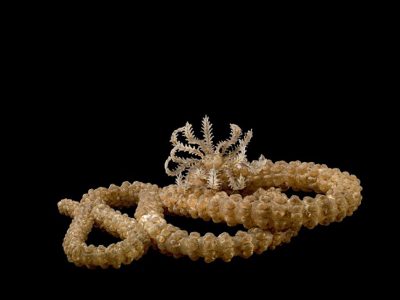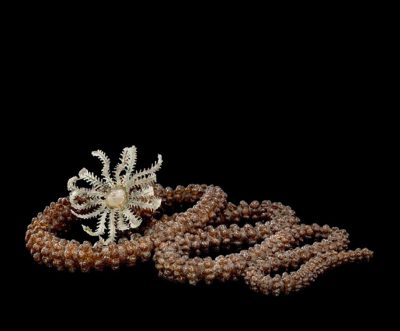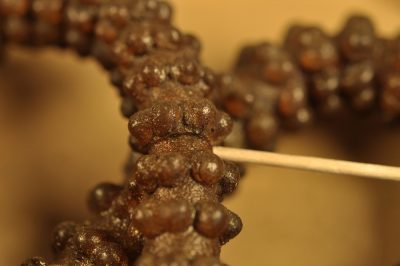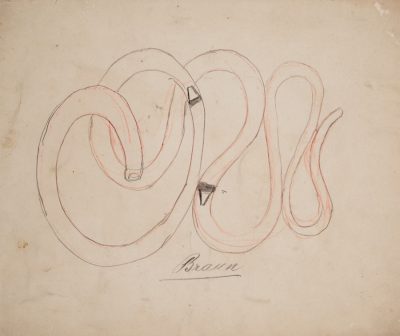
Blaschka Nr. 287: Synapta maculata (1885);
Synapta maculata (2016), Leopold and Rudolf Blaschka,
Dresden, Germany, 1885.
Lent by Cornell University, Department of Ecology and
Evolutionary Biology. L.17.3.63-8.
In preparation for Fragile Legacy: The Marine Invertebrate Glass Models of Leopold and Rudolf Blaschka, the museum’s conservation department treated more than 70 Blaschka models. While some models needed extensive interventions, most just needed relatively minor repairs and careful cleaning. In advance of treatment, each model was also carefully examined. One of the most exciting aspects of examining the Blaschka models is uncovering new clues to how they were created. These sea cucumber models are just some of many examples.
This blue and white sea cucumber model (Blaschka Nr. 287) has two areas that appear darker than the rest of the surface. Adhesives and paints often discolor when they age, making old repairs more visible. Because we know that some Blaschka models were treated in the past, we initially thought these darker areas were old repairs.
But upon closer inspection, we realized that these areas were actually joins made by the Blaschkas and not old repairs. At each of the two joins one section of the long tubular body was inserted into another section. Originally these joins would have been well hidden beneath the paint, now however, the adhesive has yellowed causing the paint on top to look darker.
Knowing that the body was made of three separate sections made us wonder: were the two similar models in the collection made the same way? As you can see, these other two sea cucumbers (Blaschka Nr. 282 and Nr. 284) have similarly shaped tubular bodies, but have very different surface treatments. The bumps you see are solid glass dots glued onto the body and heavily coated in paints. Although these two models had already been examined and cleaned, we didn’t look for any joins. We decided to re-examine them both.
- Blaschka Nr. 282: Synapta Beselii (1885); Synapta maculate (2016); Leopold and Rudolf Blaschka, Dresden Germany, 1885. Lent by Cornell University, Department of Ecology and Evolutionary Biology. L.17.3.63-229
- Blaschka Nr. 284: Synapta glabra (1885); Opheodesoma glabra (2016), Leopold and Rudolf Blaschka, Dresden Germany, 1885. Lent by Cornell University, Department of Ecology and Evolutionary Biology. L.17.3.63-20
The joins on these two models were a little more difficult to spot. They were well-hidden because the old adhesive didn’t affect paint color, like it did on the blue and white sea cucumber model. After close examination, we did find the joins, in almost the same locations as the first model.
At first glance, the three sea cucumber models appear to have the same serpentine shape. A close comparison reveals variation in the shapes of the tubing sections. While the Blaschkas’ standardized approach to constructing each of the models creates a similar visual effect, the differences give each individual model a more life-like quality.
- The joins on these two models were a little more difficult to spot. They were well-hidden because the old adhesive didn’t affect paint color, like it did on the blue and white sea cucumber model. After close examination, we did find the joins, in almost the same locations as the first model.
- Schematic drawing of a sea cucumber.
Further evidence of the Blaschka’s careful planning presented itself when we searched the Museum’s digitized collection of Blaschka archives. This schematic drawing shows what we saw in the models: a twisted tubular body of a sea cucumber divided into three sections. The locations of the joins in the drawing are an exact match to the joins in Blaschka model Nr. 284, the dark brown sea cucumber.
We’re not sure why these models were made in sections, but possibly it’s because of limitations in the glass tubes they purchased or perhaps it was a way to simplify their production process.
As we continue to treat Blaschka models for an upcoming exhibition at Cornell’s Johnson Museum of Art, we’re looking forward to discovering more of the secrets contained in these amazing objects.
 Fragile Legacy: The Marine Invertebrate Glass Models of Leopold and Rudolf Blaschka is on view at The Corning Museum of Glass through January 8, 2017. Learn more about the exhibition.
Fragile Legacy: The Marine Invertebrate Glass Models of Leopold and Rudolf Blaschka is on view at The Corning Museum of Glass through January 8, 2017. Learn more about the exhibition.





